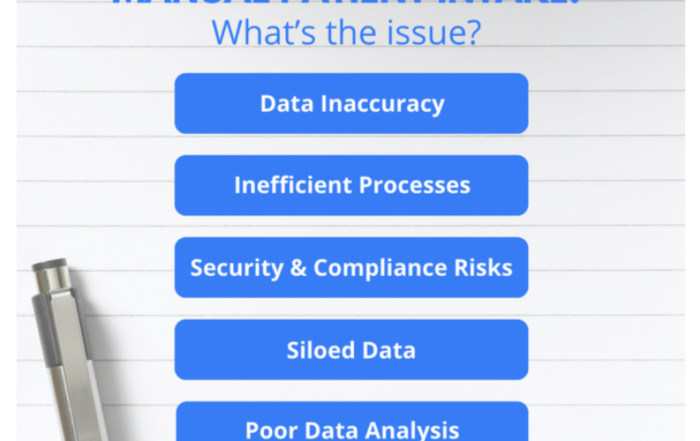
One of the trickiest parts of advertising is making sure your message is reaching the right patient at the right time. How can you avoid spinning your wheels and effectively use your marketing dollars to reach your ideal patient with a message that will encourage, nurture and convert them?
Easy. The answer is developing patient personas.
The most successful medical practices today mirror what profitable companies have been doing for years — developing buyer personas based on answering three critical questions:
- Who are you going to talk to?
- Why will they care?
- What are you going to say that matters to them?
Have you ever stopped to ask yourself who your ideal patient actually is?
It may seem trivial, and even redundant, but most medical practices skip this all-too-critical first step when developing a marketing strategy. If you think your patients will line up out the door just because you scream your message loud enough – think again.
Plain and simple, advertising is expensive. And with the attention span of your average person now standing at eight seconds (ranked just below a goldfish), customized messaging is of the utmost importance. Why should they care about what you’re saying? How is the message going to be delivered to them?
Partial Knee Replacements: An Example
As an example, think of a knee surgeon who wants to get more outpatient, partial knee replacements scheduled. A mom of three may need a new knee just as much as an avid jogger about to enter his golden years, but the imaging and messaging for each are quite different.
One will care about getting back to her kids and not missing the moments they can share, and one will care more about how quickly they can return to the beach for their morning walks.
“You can’t replace the moments you miss,” vs. “Get back to doing what you love.”
It was essentially the same message but tweaked to the different patient personas. The images change to reflect and resonate with what they care about, therefore increasing conversion rates.
The good news is that today’s digital advertising technology gives us the ability to deliver highly targeted ads that perform better than ever before based on age, interest, hobbies and a whole lot more. Creating your personas is the first step to crafting the correct message and getting in front of the right patients at the right time. Having personas in place before you dive in will save you time and money in all your marketing efforts.
Below we’ll outline how to identify and create your ideal patient profile, and give you some proven tactics you can use to reach them with the right message at exactly when they need your services.

The Power of Patient-Focused Digital Advertising
Technology has provided advertisers with powerful tools to reach our ideal audiences and to convert customers like never before. Between Google AdWords and Facebook Advertising, you can tell what your patient has searched for online, their marital status, the neighborhood they live in, how many children they have, lifestyle preferences, and even what kind of computer they use.
How does this massive access to information impact your medical practice?
Information is power. Access to this data allows you to identify, create, and track the optimal patient personas for your practice and tailor unique messages to address their needs and assuage their particular pain points.

What exactly is a persona? According to the standard definition, a persona is: “a synopsis of the characteristics, needs, motivations, and environment of a particular kind of website user.“
In short, before you can craft and broadcast your message, you first need to understand and create your ideal patient profile to ensure that your message hits its target. You need to have a better understanding of your patient right out of the gate, or you might as well just dump your advertising budget down the drain.
The instantaneously-efficient world of digital marketing allows you to understand exactly what works and how much it takes to attract and retain that coveted new patient.
How to Create Your Patient Persona(s)
 To get your offering to the ideal patient, at the right time, with the optimal message, you’re first going to have to identify who your right patient is. This practice is MO number one for everything related to marketing — an exercise all profitable businesses and organizations perform regularly. If you feel slightly intimidated, don’t be; it’s not rocket science and can be done with a quick brainstorming session.
To get your offering to the ideal patient, at the right time, with the optimal message, you’re first going to have to identify who your right patient is. This practice is MO number one for everything related to marketing — an exercise all profitable businesses and organizations perform regularly. If you feel slightly intimidated, don’t be; it’s not rocket science and can be done with a quick brainstorming session.
Simply ask yourself what are the characteristics and motivations of the patients you particularly enjoy working with? And what traits do they have in common regarding:
- Name them (ex: “Mom” persona is named Sarah)
- Health attitudes
- Income level
- Pain Points she experiences about going to the doctor
- Occupation
- Interests
- Personal habits
- Age
- Methods of payment
By no means should you turn away patients who do not meet your “ideal” criteria; the goal here is to make a concerted effort to attract a certain quality of patient vs. aiming for a generic ever-growing quantity of patients.
Get the difference? Simply put: it’s quality over quantity. Knowing and understanding your ideal patient will lay the foundation for a profitable and personally-fulfilling practice.
Start Where You Are
 All this is fine and dandy in theory, but how do you go about identifying your perfect patient?
All this is fine and dandy in theory, but how do you go about identifying your perfect patient?
The most efficient way of selecting your patient persona is to segment data across your medical practice in a clear and coherent manner. Begin with the actual patients you have. Most likely, you’ve seen hundreds or even thousands of patients over the years.
Pull out your recent patient charts for any given day or from several days. Go through each chart and stack them in order of desirability, from 1 to 5 (1 being the best score and five the lowest). Your category 1 and two patients are those who are a pleasure to serve, who benefit from what you have to offer, and who will refer other like patients to you in the future (or came from a referral source who will).
Once you’ve identified your two best groups, take a look at what traits they have in common. What was their reason for coming? What kind of work do they do, white or blue-collar? Are they married? How old are they? Were their health problems similar? Do they have insurance? Do they share common health attitudes?
There is no cookie-cutter recipe here. Your analysis might lead you to conclude that the characteristics and values of your ideal patient transcend the boundaries of demographics. Perhaps a unique attitude will describe them.

What Makes Them Tick?
After imagining and choosing your ideal patients, put yourself in their shoes.
If you want to connect with them on a personal level and make them feel understood, you’re going to need to think as they do. And unfortunately, no one can do this exercise for you!
Here are some questions that will help point you in the right direction.
- What is their greatest worry or concern?
- What issue keeps them tossing and turning at night?
- What are their general values?
- What is most important to them?
Take your answers to these questions and determine how you can assuage their concerns and worries and improve their lives. Write everything down. These are the key benefits you’ll target when developing your marketing strategy to reach each unique persona.
Patient personas are more than hypothetical characters – they typify actual people who are given a name, and assigned a demographic, behavior patterns, and goals. Those ingredients combine to form a portrait of your practice’s wider target audience enabling you to design the optimal user experience for patients at all touchpoints. A true recipe for driving success and increasing revenue.
Here’s another example. A young family practice doctor appreciates serving busy, hip, young executives who are on the go, have a tight schedule, and often travel. The persona is named “Darren.” He caters to Darren and his hip executive friends locally and offers telemedical care for long-standing patients during their travels. Darren is 36, makes over $80,000 a year, is married with a young child and hates when he has to wait to see the doctor.
So, for this particular patient, they are offered priority scheduling with a guaranteed 15-minute or less wait time. This patient is completely different from “Lisa,” so the practice advertising and benefits are shifted when speaking to her – a new grandmother that hasn’t been on a plan in 5 years, and has nothing but time on her hands.
Your Ideal Patient
 Meet Steph.
Meet Steph.
She’s 43-years old, recently divorced with two children (a boy and a girl) who lead very active lives, from gymnastics to music lessons, to the swimming team. Steph is a real estate agent specializing in commercial property. Facebook is where she spends a lot of her free time (because her friends are there), and she often can be found on Instagram and Snapchat (that’s where her kids hang out).
Between work, rushing the kids off to school, the family’s evening routine, and her favorite Netflix series, time is Steph’s most precious resource – she has so little of it! It also happens to be her biggest pain point. She reads BuzzFeed and loves the Karate Kid (who doesn’t?). She has Cigna/Aetna insurance (how did we figure that out? Simple — we researched what kind of insurance was offered by her employer).
Here are some other examples of Steph’s traits, values, and motivations:
Goals:
She wants a quiet corner to unwind and not have to interact with people
Values:
She values her time immensely and does not like to waste one second. She prefers to plan her appointments ahead of time
Challenges:
She often reserves last-minute services and expects availability
Pain Points
Steph’s time is precious and is very short supply. She is also on a tight budget
Objections to the Sale
The sale transaction needs to be fast and affordable; Steph has two kids who will be going to college
Role in the Purchase Process
She is the decision maker working with a limited budget
What kinds of messages will resonate with her?
- Save Time and Money – drop in to see a physician today, no appointment needed
- Look Younger and Feel Great Every Day
- Let Us Do the Heavy Lifting For You
- Beautiful and powerful images and graphics with minimal text (She can’t be bothered to read a 5-minute article, so she reads and digests her news in chunks – blame BuzzFeed)
- How to Be the Greatest and Happiest Mom You Can Be
Crafting a Message to Convert
Now that you know Steph (and her pain points), you can design the ideal message that will reverberate with her wants, values, and needs and give you the greatest chance of converting her from potential patient to ardent fan.

Of course, Steph isn’t your only preferred type of patient. There’s also Matt (a single, graduate student in his mid-20s), Tom (an account manager with four children), and Daphne (a young stay at home mother in her early 30s). Plus all their friends, relatives, and professional networks.
Every persona you identify provides you with an opportunity to design tailor-made messages to address their specific pain points. The bottom line: developing your persona profiles will help you attract the exact kinds of patients you’re looking for with the perfect message to get them through the door.
The young family doctor mentioned in the previous example may take this information and use it not only to craft specific messages, but he may also use it to inform his new office remodel. He takes steps to transform his practice’s physical space and his services to meet the needs of his preferred patient. He equips his waiting room with trendy, urban, cafe-style chairs, free wireless internet, and offers coffee, tea, snacks, and bottled water.
He also offers his executive patients flexible, walk-in hours earlier and later than normal office hours. His patients are able (online) to set up 15-20 minute phone consultations with him while they are traveling.
The Benefits of Creating Personas
 Patient personas allow you to develop advertising that converts: you’ll see better results, higher ROI, and save time and money because you’ve been guessing until now.
Patient personas allow you to develop advertising that converts: you’ll see better results, higher ROI, and save time and money because you’ve been guessing until now.
As technology evolves, your marketing approach will need to follow suit (or get left behind in the dust). Developing patient personas pays great dividends to the long-term success and bottom line of your practice.
Personas allow you to:
- Boost conversions: by pinpointing and mapping out your ideal patient’s journey, you can optimize the tone and style of your content to appeal to and delight your target user
- Make sure your website is responsive to your patient’s needs
- Improve the navigation, content, and user-friendliness of your site
- Promote site integration with other subspecialty networks and increase referrals
- Track results based on objective data and adapt your strategy based on clear research-led assumptions about target patients
Every doctor and medical practice can identify and define their unique patient personas, learn where they hang out, design systems that attract and captivate them and get them in the examination room.
It all starts with the simple question “Who do I love to treat?” And from there laying the foundation for getting out there and attracting more of the same.










